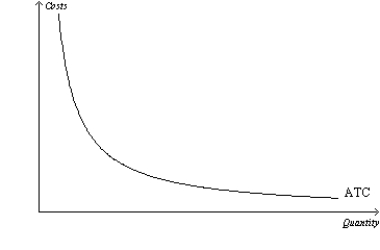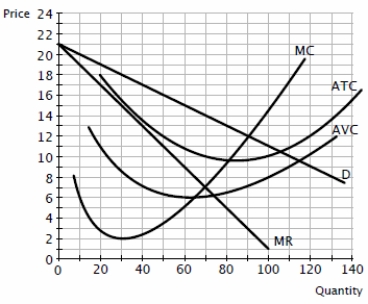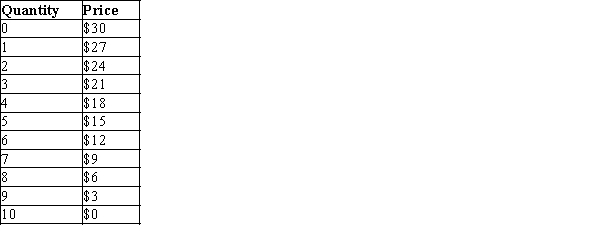A) constrained by the market demand curve.
B) constrained by market supply.
C) not affected by market demand.
D) enhanced by regulatory control of the government.
F) B) and C)
Correct Answer

verified
Correct Answer
verified
True/False
A patent gives a single person or firm the exclusive right to sell some good or service forever.
B) False
Correct Answer

verified
Correct Answer
verified
Multiple Choice
Which of the following would be most likely to have monopoly power?
A) a national florist
B) an online bookstore
C) a local restaurant
D) a local electrical cooperative
F) A) and B)
Correct Answer

verified
Correct Answer
verified
Multiple Choice
Figure 15-1  -Refer to Figure 15-1. The shape of the average total cost curve in the figure suggests an opportunity for a profit-maximizing monopolist to take advantage of
-Refer to Figure 15-1. The shape of the average total cost curve in the figure suggests an opportunity for a profit-maximizing monopolist to take advantage of
A) economies of scale.
B) diseconomies of scale.
C) diminishing marginal product.
D) increasing marginal cost.
F) All of the above
Correct Answer

verified
Correct Answer
verified
Multiple Choice
Figure 15-22
The diagram depicts the market situation for a monopoly pastry shop called Bearclaws.  -Refer to Figure 15-22. Based upon the information shown, what is total revenue for Bearclaws, given that it maximizes profits?
-Refer to Figure 15-22. Based upon the information shown, what is total revenue for Bearclaws, given that it maximizes profits?
A) $900.
B) $980.
C) $490.
D) $1080.
F) A) and C)
Correct Answer

verified
Correct Answer
verified
True/False
If a product can be produced by a natural monopoly, society will benefit in the form of lower prices if the monopolist is broken up into several smaller firms.
B) False
Correct Answer

verified
Correct Answer
verified
Multiple Choice
A patent gives the inventor monopoly control over the patented good. Patents also
A) lead to lower prices for goods.
B) create incentives to develop new products.
C) lead to an increase in the number of producers of the patented good.
D) lead to increased entry into the market for the patented good.
F) C) and D)
Correct Answer

verified
Correct Answer
verified
Multiple Choice
Price discrimination is a rational strategy for a profit-maximizing monopolist when
A) the monopolist finds itself able to produce only limited quantities of output.
B) consumers are unable to be segmented into identifiable markets.
C) the monopolist wishes to increase the deadweight loss that results from profit-maximizing behavior.
D) there is no opportunity for arbitrage across market segments.
F) B) and C)
Correct Answer

verified
Correct Answer
verified
Short Answer
Scenario 15-1
Vincent operates a scenic tour business in Boston. He has one bus which can fit 50 people per tour and each tour lasts 2 hours. His total cost of operating one tour is fixed at $450. Vincent's cost is not reduced if he runs a tour with a partially full bus. While his cost is the same for all tours, Vincent charges each passenger his/her willingness to pay: adults $18 per trip, children $10 per trip, and senior citizens $12 per trip. At those rates, on a typical day Vincent's demand is:  Assume that Vincent's customers are always available for the tour; therefore, he can fill his bus for each tour as long as there is sufficient total demand for the day.
-Refer to Scenario 15-1. What is Vincent's cost of serving all passengers demanding a tour on a typical day?
Assume that Vincent's customers are always available for the tour; therefore, he can fill his bus for each tour as long as there is sufficient total demand for the day.
-Refer to Scenario 15-1. What is Vincent's cost of serving all passengers demanding a tour on a typical day?
Correct Answer

verified
Correct Answer
verified
Multiple Choice
Table 15-20
A monopolist faces the following demand curve:  -Refer to Table 15-20. If a monopolist faces a constant marginal cost of $20, how much output should the firm produce in order to maximize profit?
-Refer to Table 15-20. If a monopolist faces a constant marginal cost of $20, how much output should the firm produce in order to maximize profit?
A) 2 units
B) 3 units
C) 4 units
D) 5 units
F) C) and D)
Correct Answer

verified
Correct Answer
verified
Multiple Choice
The price effect describes the situation when a monopolist lowers the price of output and, all else equal, total revenue
A) increases.
B) decreases.
C) is unchanged.
D) is maximized.
F) B) and D)
Correct Answer

verified
Correct Answer
verified
Multiple Choice
If a monopolist has zero marginal costs, it will produce
A) the output at which total revenue is maximized.
B) in the range in which marginal revenue is still increasing.
C) at the point at which marginal revenue is at a maximum.
D) in the range in which marginal revenue is negative.
F) A) and D)
Correct Answer

verified
Correct Answer
verified
Multiple Choice
Economists assume that monopolists behave as
A) cost minimizers.
B) profit maximizers.
C) price maximizers.
D) maximizers of social welfare.
F) B) and D)
Correct Answer

verified
Correct Answer
verified
Multiple Choice
A perfectly competitive market
A) may not be in the best interests of society, whereas a monopoly market promotes general economic well-being
B) promotes general economic well-being, whereas a monopoly market may not be in the best interests of society.
C) and a monopoly market are equally likely to promote general economic well-being.
D) is less likely to promote general economic well-being than a monopoly market.
F) A) and D)
Correct Answer

verified
Correct Answer
verified
Multiple Choice
Which of the following is not an example of price discrimination by a firm?
A) children's meals at a restaurant
B) a natural gas company charging customers a higher rate in the winter than in the summer
C) a senior citizens' discount
D) coupons in the Sunday newspaper
F) A) and D)
Correct Answer

verified
Correct Answer
verified
Multiple Choice
Which of the following are necessary characteristics of a monopoly? (i) The firm is the sole seller of its product. (ii) The firm's product does not have close substitutes. (iii) The firm generates a large economic profit. (iv) The firm is located in a small geographic market.
A) (i) and (ii) only
B) (i) and (iii) only
C) (i) , (ii) , and (iii) only
D) (i) , (ii) , (iii) , and (iv)
F) All of the above
Correct Answer

verified
Correct Answer
verified
Multiple Choice
Scenario 15-7 Black Box Cable TV is able to purchase an exclusive right to sell a premium movie channel (PMC) in its market area. Let's assume that Black Box Cable pays $150,000 a year for the exclusive marketing rights to PMC. Since Black Box has already installed cable to all of the homes in its market area, the marginal cost of delivering PMC to subscribers is zero. The manager of Black Box needs to know what price to charge for the PMC service to maximize her profit. Before setting price, she hires an economist to estimate demand for the PMC service. The economist discovers that there are two types of subscribers who value premium movie channels. First are the 4,000 die-hard TV viewers who will pay as much as $150 a year for the new PMC premium channel. Second, the PMC channel will appeal to 20,000 occasional TV viewers who will pay as much as $20 a year for a subscription to PMC. -Refer to Scenario 15-7. If Black Box Cable TV is able to price discriminate, what would be the maximum amount of profit it could generate?
A) $500,000
B) $600,000
C) $850,000
D) $925,000
F) C) and D)
Correct Answer

verified
Correct Answer
verified
True/False
In a monopoly market, the socially efficient quantity of output is typically higher than the profit-maximizing quantity of output for the monopolist.
B) False
Correct Answer

verified
Correct Answer
verified
Multiple Choice
For a profit-maximizing monopolist,
A) P > MR = MC.
B) P = MR = MC.
C) P > MR > MC.
D) MR < MC < P.
F) A) and D)
Correct Answer

verified
Correct Answer
verified
Multiple Choice
The laws governing patents and copyrights
A) eliminate the need for firms to engage in research and development.
B) are intended to serve private interests, not the public's interest.
C) reduce fixed costs for firms that obtain them.
D) None of the above is correct.
F) B) and D)
Correct Answer

verified
Correct Answer
verified
Showing 501 - 520 of 662
Related Exams